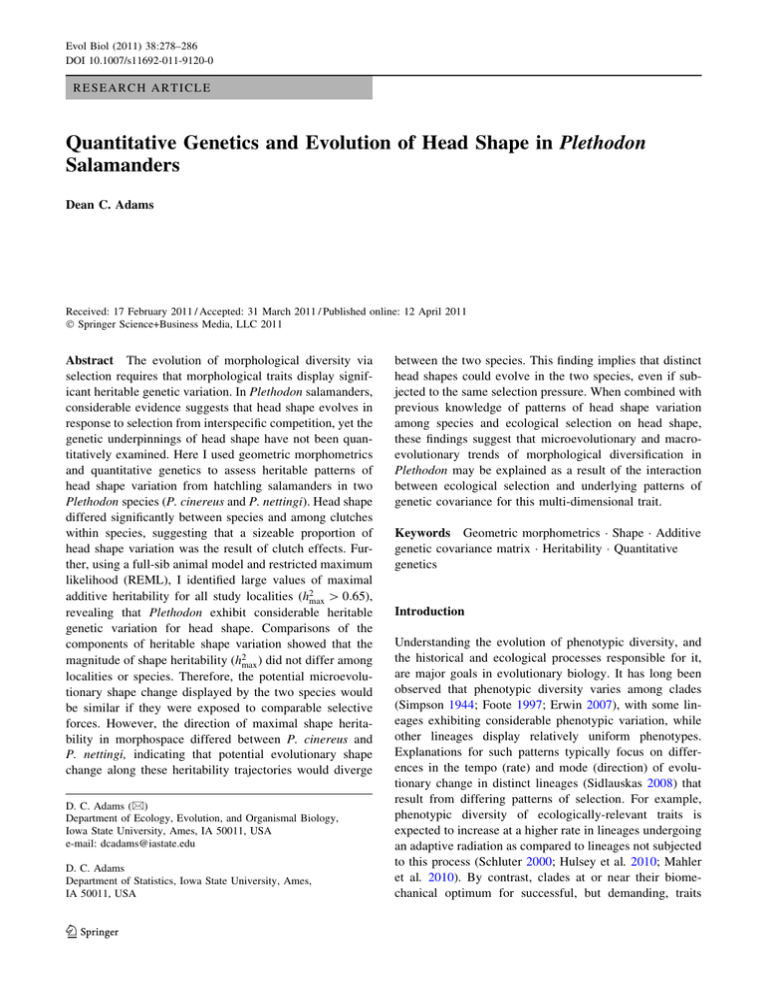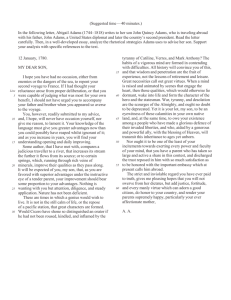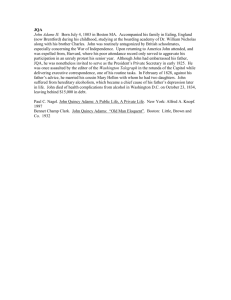Quantitative Genetics and Evolution of Head Shape in Plethodon Salamanders
advertisement

Evol Biol (2011) 38:278–286 DOI 10.1007/s11692-011-9120-0 RESEARCH ARTICLE Quantitative Genetics and Evolution of Head Shape in Plethodon Salamanders Dean C. Adams Received: 17 February 2011 / Accepted: 31 March 2011 / Published online: 12 April 2011 Ó Springer Science+Business Media, LLC 2011 Abstract The evolution of morphological diversity via selection requires that morphological traits display significant heritable genetic variation. In Plethodon salamanders, considerable evidence suggests that head shape evolves in response to selection from interspecific competition, yet the genetic underpinnings of head shape have not been quantitatively examined. Here I used geometric morphometrics and quantitative genetics to assess heritable patterns of head shape variation from hatchling salamanders in two Plethodon species (P. cinereus and P. nettingi). Head shape differed significantly between species and among clutches within species, suggesting that a sizeable proportion of head shape variation was the result of clutch effects. Further, using a full-sib animal model and restricted maximum likelihood (REML), I identified large values of maximal additive heritability for all study localities (h2max [ 0:65), revealing that Plethodon exhibit considerable heritable genetic variation for head shape. Comparisons of the components of heritable shape variation showed that the magnitude of shape heritability (h2max ) did not differ among localities or species. Therefore, the potential microevolutionary shape change displayed by the two species would be similar if they were exposed to comparable selective forces. However, the direction of maximal shape heritability in morphospace differed between P. cinereus and P. nettingi, indicating that potential evolutionary shape change along these heritability trajectories would diverge D. C. Adams (&) Department of Ecology, Evolution, and Organismal Biology, Iowa State University, Ames, IA 50011, USA e-mail: dcadams@iastate.edu D. C. Adams Department of Statistics, Iowa State University, Ames, IA 50011, USA 123 between the two species. This finding implies that distinct head shapes could evolve in the two species, even if subjected to the same selection pressure. When combined with previous knowledge of patterns of head shape variation among species and ecological selection on head shape, these findings suggest that microevolutionary and macroevolutionary trends of morphological diversification in Plethodon may be explained as a result of the interaction between ecological selection and underlying patterns of genetic covariance for this multi-dimensional trait. Keywords Geometric morphometrics Shape Additive genetic covariance matrix Heritability Quantitative genetics Introduction Understanding the evolution of phenotypic diversity, and the historical and ecological processes responsible for it, are major goals in evolutionary biology. It has long been observed that phenotypic diversity varies among clades (Simpson 1944; Foote 1997; Erwin 2007), with some lineages exhibiting considerable phenotypic variation, while other lineages display relatively uniform phenotypes. Explanations for such patterns typically focus on differences in the tempo (rate) and mode (direction) of evolutionary change in distinct lineages (Sidlauskas 2008) that result from differing patterns of selection. For example, phenotypic diversity of ecologically-relevant traits is expected to increase at a higher rate in lineages undergoing an adaptive radiation as compared to lineages not subjected to this process (Schluter 2000; Hulsey et al. 2010; Mahler et al. 2010). By contrast, clades at or near their biomechanical optimum for successful, but demanding, traits Evol Biol (2011) 38:278–286 may be constrained in their morphological evolution and hence have lower evolutionary rates (e.g., Collar et al. 2009). Changes in the tempo or mode of evolution may also be observed when lineages evolve a novel anatomical innovation, particularly when several unique traits co-evolve (e.g., Price et al. 2010). With the advent of new theoretical approaches in comparative evolutionary biology (Butler and King 2004; O’Meara et al. 2006; Revell 2008), researchers can now evaluate both the tempo and mode of phenotypic evolution in a phylogenetic context, providing a quantitative link between microevolutionary dynamics that drive phenotypic change and the macroevolutionary trends of phenotypic diversification that result from such processes (e.g., McPeek et al. 2008; Collar et al. 2010; Harmon et al. 2010). In some circumstances, the microevolutionary responses to common ecological selective pressures are similar in distinct taxa or localities, suggesting that patterns of phenotypic diversification can be repeatable (Losos 1992; Schluter and McPhail 1992; Reznick et al. 1996; Adams 2010). Such parallel patterns of diversification provide strong evidence of adaptation, and reveal the power of natural selection to shape phenotypic evolution (Schluter 2000; Harmon et al. 2003). Indeed, microevolutionary changes in phenotypic traits are often hypothesized to be the result of selection (e.g., Jastrebski and Robinson 2004; Grant and Grant 2006; Arnegard et al. 2010; Kaliontzopoulou et al. 2010), and these processes are thought to play an important role in shaping macroevolutionary patterns at higher scales as well (Schluter 2000; Harmon et al. 2003; Butler et al. 2007). However, an important assumption of selection-based hypotheses is that sufficient genetic variation for the trait is present, because adaptive evolution can only occur if there is heritable genetic variation for the traits experiencing selection (Lande 1979). Otherwise, any changes observed in those traits will not constitute longterm evolutionary adaptations. The salamanders of the genus Plethodon provide an interesting opportunity to examine the genetic underpinnings of morphological change. Plethodon are long-lived terrestrial salamanders found in North American forests (Highton 1995). Considerable field collecting has documented their geographic distributions, and decades of behavioral and ecological research has shown that the effects of interspecific competition can be pervasive (Jaeger 1971; Hairston 1980; Anthony et al. 1997; Marshall et al. 2004). In some geographic regions, the ranges of potential competitors have been restricted as a result of interspecific competition (Jaeger 1970; Hairston 1980; Griffis and Jaeger 1998), and species interactions likely play a large role in shaping community structure at higher spatial scales as well (Adams 2007). Additionally, extensive variation in body size (Adams and Church 2008) and 279 head shape exists, with the latter being particularly important in species interactions. Specifically, head shape variation is associated with other ecologically relevant characteristics, including food resource use (Adams 2000; Adams and Rohlf 2000; Maerz et al. 2006), and behavioral aggression (Adams 2004, 2010). Thus, there is a direct functional link between head shape variation and the ecological forces that dominate species interactions. Finally, some species display morphological changes in geographic regions where congeneric competitors are present. For instance, some interacting species exhibit greater morphological differences in head shape in sympatry as compared to in allopatry (character displacement: Adams 2000, 2004, 2010; Adams and Rohlf 2000; Adams et al. 2007), though in other cases, more unique phenotypic changes are observed (e.g., Arif et al. 2007; Myers and Adams 2008). Taken together, these observations suggest that interspecific competition is an important selective force in Plethodon communities, which in some instances has driven microevolutionary changes in head shape among competing species. The scenario described above implies that changes in head shape represent adaptive responses to natural selection resulting from competitive interactions among species. Nonetheless, although the observed morphological and ecological patterns are consistent with this explanation for numerous species of Plethodon, this hypothesized mechanism can only drive morphological change if heritable genetic variation for head shape exists, so that the response to ecological selection can persist evolutionarily (Lande 1979; Lande and Arnold 1983). To date, this prediction has not been quantitatively examined. In this study, I used multivariate approaches and evolutionary quantitative genetics to examine heritable patterns of head shape variation in Plethodon, to determine whether or not head shape exhibits a strong genetic component. Materials and Methods Specimens and Data Collection A total of 1,369 hatchling salamanders from 232 clutches (families) of two species were obtained from the collections of the Smithsonian National Museum of Natural History (NMNH). For one species, Plethodon cinereus, hatchlings were from two geographic localities: Shenandoah National Park (SNP), Greene County, Virginia (151 clutches), and Jefferson National Forest (JNF), Giles County, Virginia (44 clutches). For the other species, P. nettingi, hatchlings were from one geographic locality: Monongahela National Forest (MNF), Randolph County, West Virginia (37 clutches). These hatchlings were 123 280 Evol Biol (2011) 38:278–286 10 7 8 6 5 4 9 3 1 2 11 Fig. 1 Positions of 11 anatomical landmarks used to characterize head shape in Plethodon salamanders (image from Adams et al. 2007) originally collected for genetic studies (e.g., Highton 1959, 1960, 1975), including an examination of the genetic inheritance of trunk vertebrate (Highton 1960). Specimens were obtained as clutches of eggs or as hatchlings found in the field with their associated female (JNF and MNF), or by placing gravid females in individual containers (SNP), where they subsequently deposited eggs and remained with the embryos until hatching (R. Highton, pers. comm.; see also Highton 1975). From each hatchling salamander, I quantified head shape using geometric morphometric methods (Bookstein 1991; Rohlf and Marcus 1993; Adams et al. 2004; Zelditch et al. 2004). These methods quantify the shape of anatomical objects using the coordinates of biologically homologous landmarks, after the effects of non-shape variation have been mathematically held constant. First, digital images were obtained using a Nikon DXM-1200 high-resolution digital camera, mounted to a Nikon SMZ1500 stereomicroscope. Next, the locations of 11 homologous landmarks were recorded on each specimen (Fig. 1). Variation in the gape of each salamander was taken into account by rotating the landmarks on the mandible so that the angle between the skull and mandible was invariant among specimens (Adams 1999). Specimens were then optimally aligned using a Generalized Procrustes analysis (Rohlf and Slice 1990), and from the aligned specimens Procrustes tangent coordinates were obtained and treated as a set of shape variables for all subsequent analyses (e.g., Mitteroecker and Bookstein 2008; Adams and Nistri 2010; Kelly and Adams 2010; Piras et al. 2010). Statistical Analyses To assess variation in head shape among study localities I used a nested MANOVA, where clutch was treated as a nested effect (within locality). I then used MANOVA to evaluate patterns of head shape variation among clutches within each of the three study localities. To determine whether variation in head shape was genetically inherited, I estimated the genotypic and phenotypic variance 123 components of head shape for each study location using restricted maximum likelihood (REML) as implemented in VCE 6 (Groeneveld et al. 2008). I included all shape variables in the analysis, and used a full-sib animal model (Lynch and Walsh 1998), with clutch treated as a random effect (e.g., Myers et al. 2006). Although multiple paternity has been observed in a population of P. cinereus (Liebgold et al. 2006), the sires of hatchlings in this study were unknown. Thus, treating hatchlings as full-sibs (rather than half-sibs) provides a conservative estimate of heritability in such scenarios (see Myers et al. 2006). From this multivariate quantitative genetic model, the additive genetic (G) and phenotypic (P) covariance matrices of head shape were obtained. Next, using the multivariate generalization of the breeders’ equation: Dz ¼ GP S (Lande 1979; Lande and Arnold 1983), the matrix GP2 was estimated (where P2 is the generalized inverse), which is the multivariate analog of heritability (see Roff 2000). The dominant eigenvector of this matrix (E1) describes the direction of maximal response to selection in phenotype space (Klingenberg and Leamy 2001; Klingenberg et al. 2010), and its corresponding eigenvalue is an estimate of the maximum additive heritability, h2max (Efimov et al. 2005; Myers et al. 2006). For each study locality, confidence intervals for h2max were obtained by bootstrapping. Here, families within each study locality were sampled with replacement, the G and P matrices were recalculated, and a new estimate of h2max was obtained. This process was then repeated 999 times for each study locality to obtain a set of h2max values, from which 95% percentile confidence intervals were calculated. Patterns of heritable shape change were also compared among study localities by examining both the magnitude and direction of heritable shape change. These components can be disentangled when the multivariate (but not univariate) approach to shape heritability is utilized (Klingenberg and Monteiro 2005; Myers et al. 2006; see also Monteiro et al. 2002; Klingenberg 2003 for discussion). I then tested whether the magnitude and direction of heritable shape change differed significantly between study locations. To accomplish this, I first calculated all observed pairwise differences between study localities for the mag nitude of heritability (e.g., D12 ¼ abs h2max 1 h2max 2 ), as well as differences in the direction of maximum heritability in phenotype space, found as the angle between dominant eigenvectors of GP2 for pairs of study localities (e.g., h12 ¼ cos1 ðEt1;1 Et1;2 Þ). I then bootstrapped families within each study locality separately, recalculated GP2, E, and h2max for each study location, and obtained new estimates of the differences between study localities (D and h). This process was repeated 999 times and the proportion of bootstrap-generated values that exceeded the observed values was treated as the significance level (see also Adams Evol Biol (2011) 38:278–286 and Collyer 2007, 2009; Collyer and Adams 2007). Finally, patterns of shape variation were visualized using principal components analysis, and thin-plate spline deformation grids were generated along the dominant eigenvector of GP2 for each study location to facilitate description of anatomical trends in heritable shape change. Genetic and phenotypic covariance matrices were obtained using VCE 6 (Groeneveld et al. 2008), while all other statistical computations and bootstrapping procedures were performed in R 2.12 (R Development Core Team 2010). 281 Using nested MANOVA, I found significant differences in head shape among the three study localities (Pillai’s trace = 0.943; Prand = 0.0001). Based on Euclidean distances between locality means, differences in head shape between P. nettingi and P. cinereus were twice as large as the difference between the two study localities of P. cinereus (DP.nett,P.cin(Shen) = 0.0563; DP.nett,P.cin(Jeff) = 0.0662; DP.cin(Jeff),P.cin(Shen) = 0.0252; all significant at Prand = 0.001). This result was visually confirmed by principal components analysis, where there was considerably greater overlap among individuals from the two study localities for P. cinereus than there was among individuals from the two species (Fig. 2a). Head shape also varied significantly between clutches in all study localities (Table 1), implying that a sizeable proportion of the observed variation in head shape was due to clutch effects. The analysis of GP2 revealed that for all study localities, the proportion of variation associated with the dominant eigenvector (E1) was considerably greater than that associated with the remaining shape dimensions, and that the remaining shape dimensions explained little of the total variation (Fig. 3a). Similar patterns were also found when both G and P were analyzed separately (Fig. 3b, c), implying that most of the genetic and phenotypic variation was concentrated in the first shape dimension. These results further suggested that the response to selection would be very strong in the direction of E1 for all study localities (see e.g., Klingenberg et al. 2010). Indeed, the maximum additive shape heritability was large (h2max [ 0:65) for all study localities (Table 2), implying that a considerable proportion of head shape variation was genetically inherited. Finally, there were no significant differences in the magnitude of shape heritability displayed among study localities, suggesting that the amount of shape heritability was similar across study localities and species (Table 3). In contrast to the magnitude of shape heritability, large differences were observed in the direction of the dominant eigenvector of GP2 for each study location (E1). This was particularly true for P. nettingi, whose dominant eigenvector was nearly orthogonal to those obtained from the two localities for P. cinereus (70° and 89°). This result was visually confirmed by projecting the dominant eigenvectors (E1) for each study location into the phenotypic data space represented by PC1 and PC2 (Fig. 2b). When assessed statistically, I found that the direction of E1 for P. nettingi differed significantly from the E1 of P. cinereus from JNF (Table 3), implying that the direction of maximal response to selection in shape space was not the same for the two species. Thus, while the magnitude of shape heritability was consistent across the three study localities, the direction of maximal shape heritability was not. Differences in Fig. 2 a Plot of the first two dimensions of a principal components analysis of head shape for 1,369 hatchling Plethodon salamander specimens. The first two dimensions explain 52% of the total variation in shape. Study localities are designated as: P. cinereus Shenandoah (open circles), P. cinereus Jefferson (black circles), P. nettingi (gray squares). b Plot of the dominant eigenvector of GP2 for each study location (originating on group mean), which represents the primary direction of shape heritability (E1). For each study location, 90% confidence ellipses based on individuals within each study location are shown. Dominant eigenvectors of GP2 for each study location are designated as: P. cinereus (solid line), P. cinereus Jefferson (dotted line), P. nettingi (dashed line) Results 123 282 Evol Biol (2011) 38:278–286 Table 1 Statistical results from MANOVA examining variation in head shape among clutches for each of the three study localities Study location NClutch Pillai’s trace Fapprox df P. cinereus (Shenandoah) P 2700, 12960 \0.0001 3.089 774, 4284 \0.0001 P. nettingi 36 5.699 2.304 648, 3222 \0.0001 Table 2 Estimates of maximum additive heritability (h2max ) as found from the dominant eigenvalue of GP2 for each study location Study location 0.2 0.4 0.6 A 1.0 2.922 6.447 0.8 6.811 43 % Explained of GP- 151 P. cinereus (Jefferson) P. cinereus (Shenandoah) 151 871 P. cinereus (Jefferson) 43 282 0.767 0.492–0.917 0.819 0.514–0.989 P. nettingi 36 216 0.669 0.459–0.948 0.0 1.0 0.2 0.4 0.6 0.8 Interestingly, similar differences in head shape were observed between adult specimens of these species from geographic localities where both species coexist in sympatry and presumably interact competitively (Adams et al. 2007 and references therein). 0.4 0.6 0.8 1.0 Discussion 0.2 0.0 % Explained of P C CI The number of clutches and number of individuals per study location are shown. Percentile confidence intervals are based on 999 iterations of a bootstrap procedure (see text) 0.0 % Explained of G B NClutch NIndividuals h2max P. cinereus (Shenandoah) P. cinereus (Jefferson) P. nettingi Fig. 3 a Eigenvalues of the matrix GP2, which correspond to the heritabilities of the shape variables associated with the respective eigenvectors. The dominant eigenvalue describes the direction of maximum additive heritability (h2max ) for the shape variables. Eigenvalues of GP2 are shown for each of the three study localities: P. cinereus (Shenandoah), P. cinereus (Jefferson), and P. nettingi. The eigenvalues of G and P are also shown (panels b and c) the direction of shape heritability were most noticeable when viewed as thin-plate spline deformation plots (Fig. 4). For P. nettingi, shape evolution along E1 was best described as a general deepening of the head and expansion of the posterior region of the lower jaw, whereas shape evolution along E1 for P. cinereus was best described as an anterior tilting of the front of the snout (Fig. 4). 123 How can we explain the vast amount of phenotypic diversity observed in nature? Many hypotheses posit that patterns of phenotypic diversification are largely the result of selective processes, where selection drives phenotypic change through evolutionary time. However, for evolution by natural selection to occur, heritable genetic variation for phenotypic traits must exist for selection to act upon. As such, determining the extent to which genetic inheritance contributes to patterns of phenotypic variation is of paramount importance for our understanding of both phenotypic diversification and the adaptive process. In this study I used geometric morphometrics and evolutionary quantitative genetics to examine heritable patterns of head shape variation in two species of Plethodon salamanders. My findings provide a number of unique insights into how phenotypic diversity may arise and evolve in this group. First, using a large series of hatchling salamander specimens, I found that head shape differed significantly between species, and among clutches within species. Previous studies have also revealed head shape differences among Plethodon species (e.g., Adams and Rohlf 2000; Arif et al. 2007; Adams 2010), including differences between the species examined here (Adams et al. 2007). However, earlier observations were based on comparisons Evol Biol (2011) 38:278–286 283 Table 3 Pairwise comparisons of the attributes of multivariate heritability P. cinereus (Shenandoah) P. cinereus (Jefferson) P. nettingi P. cinereus (Shenandoah) – 0.823 NS 0.584 NS P. cinereus (Jefferson) 0.0518 – 0.540 NS P. nettingi 0.0982 0.1501 – P. cinereus (Shenandoah) – 0.923 NS 0.265 NS P. cinereus (Jefferson) 27.5799 – 0.022* P. nettingi 70.1090 89.0400 – A: abs h2max 1 h2max 2 B: h12 ¼ cos1 Et1;1 E1;2 (A) Differences in the magnitude of maximum additive heritability (h2max ) among study localities, and (B) differences in the angular direction of the dominant eigenvectors (E1) of GP2 among study localities. For both heritability components, statistical significance was based on 999 iterations of a bootstrap procedure (found as the proportion of bootstrap values exceeding the observed). Significant comparisons are shown in bold Fig. 4 Thin-plate spline deformation grids visualizing shape evolution from positive to negative localities along E1, the dominant eigenvector of GP2 for: a P. cinereus Shenandoah, b P. cinereus Jefferson, and c P. nettingi A P. cinereus (Shenandoah) GP- (+/-) B P cinereus (Jefferson) GP- (+/-) P. C P. nettingi GP- (+/-) of adult specimens, whereas the patterns identified in this study were based on hatchlings. The fact that similar head shape patterns were identified in both hatchling and adult salamanders demonstrates that species-specific differences in head shape are present at earlier ontogenetic stages as well. This suggests that in some instances, discontinuities in head shape among species may persist from early developmental stages in Plethodon, though this does not preclude the possibility that allometric changes may also contribute to head shape differences among adults. Additional work is needed to compare ontogenetic trajectories of head shape among species to more fully examine this hypothesis (sensu Adams and Nistri 2010; Piras et al. 2010). Second, using quantitative genetic approaches, I found that head shape displayed a large component of heritable genetic variation, where estimates of the maximum additive shape heritability (h2max) were above 0.65 for all study localities. Similar heritability estimates for the number of trunk vertebrae were also observed in these populations of P. cinereus (Highton 1960, 1977). The heritability estimates presented here are also generally consistent with those found in other geometric morphometric studies (e.g., Klingenberg and Leamy 2001; Myers et al. 2006; Klingenberg et al. 2010; but see Monteiro et al. 2002; Gómez et al. 2009), and are equivalent to or slightly higher than those observed for other morphological traits (reviewed in Roff 1997). Such high values for h2max suggest that Plethodon salamanders exhibit sufficient genetic variation to respond to ecological selective forces acting on head shape, such as selection related to food resource use and behavioral 123 284 interactions (e.g., Adams and Rohlf 2000; Adams 2004). Furthermore, when heritability values were compared among study localities, I found that estimates of h2max were not significantly different among localities, implying that the amount of shape heritability was generally the same for the two species. This result suggests that the two species would display a similar amount of microevolutionary shape change if subjected to comparable selective forces. Interestingly, in other Plethodon species, the magnitude of observable phenotypic evolution resulting from ecological selection has been shown to be similar across replicated localities for two competing species (Adams 2004; Adams 2010). When combined with the findings presented here, these results suggest a possible link between the extent of microevolutionary shape change observed in particular populations and the potential for heritable responses to selective forces that may be responsible for them. Finally, I found that the dominant eigenvectors of head shape heritability (E1) were oriented in distinct directions in shape space for the two species. Thus, while the magnitude of the heritable genetic component of head shape was concordant between the two species, the direction of maximal heritable shape change was not. This observation suggests that even if the two species were subjected to the same selection pressures, their evolutionary responses to selection would result in distinct head shapes, as the two species would evolve along their diverging heritability trajectories. Importantly, the nature of the shape changes along the dominant eigenvector of GP2 for each species (Fig. 4) corresponded with previously observed differences in head shape for P. cinereus and P. nettingi, which have likely evolved as a response to interspecific competition (Fig. 4 in Adams et al. 2007). This similarity between the observed head shape differences and those that would result from evolution along E1 for each species suggests a quantitative link between the inherited directions of potential changes in head shape and the resulting patterns of morphological divergence observed between these Plethodon species. More broadly, when viewed in light of known selective pressures affecting head shape evolution in this group (e.g., Adams and Rohlf 2000; Adams et al. 2007; Adams 2010), this hypothesis implies that underlying patterns of genetic inheritance play an important role in influencing patterns of head shape evolution within and among species of Plethodon, and therefore may contribute to macroevolutionary trends of morphological disparity and diversification in the group. Acknowledgments I thank the staff of the Smithsonian National Museum of Natural History (NMNH) for providing specimens, and Julie Graesch (née Perrett), Katherine Weigert, Mary-Elizabeth West, for assistance with imaging and data collection. C Berns, J. Church, R. Highton, A. Kaliontzopoulou, A. Kraemer, G. Rivera, and N. Valenzuela provided valuable comments on the manuscript. This work was sponsored in part by NSF grant DEB-0446758 to DCA. 123 Evol Biol (2011) 38:278–286 References Adams, D. C. (1999). Methods for shape analysis of landmark data from articulated structures. Evolutionary Ecology Research, 1, 959–970. Adams, D. C. (2000). Divergence of trophic morphology and resource use among populations of Plethodon cinereus and P. hoffmani in Pennsylvania: A possible case of character displacement. In R. C. Bruce, R. J. Jaeger, & L. D. Houck (Eds.), The biology of Plethodontid salamanders (pp. 383–394). New York: Klewer Academic/Plenum. Adams, D. C. (2004). Character displacement via aggressive interference in Appalachian salamanders. Ecology, 85, 2664–2670. Adams, D. C. (2007). Organization of Plethodon salamander communities: Guild-based community assembly. Ecology, 88, 1292–1299. Adams, D. C. (2010). Parallel evolution of character displacement driven by competitive selection in terrestrial salamanders. BMC Evolutionary Biology, 10(72), 1–10. Adams, D. C., & Church, J. O. (2008). Amphibians do not follow Bergmann’s rule. Evolution, 62, 413–420. Adams, D. C., & Collyer, M. L. (2007). The analysis of character divergence along environmental gradients and other covariates. Evolution, 61, 510–515. Adams, D. C., & Collyer, M. L. (2009). A general framework for the analysis of phenotypic trajectories in evolutionary studies. Evolution, 63, 1143–1154. Adams, D. C., & Nistri, A. (2010). Ontogenetic convergence and evolution of foot morphology in European cave salamanders (Family: Plethodontidae). BMC Evolutionary Biology, 10(72), 1–10. Adams, D. C., & Rohlf, F. J. (2000). Ecological character displacement in Plethodon: Biomechanical differences found from a geometric morphometric study. Proceedings of the National Academy of Sciences, USA, 97(8), 4106–4111. Adams, D. C., Rohlf, F. J., & Slice, D. E. (2004). Geometric morphometrics: Ten years of progress following the ‘revolution’. Italian Journal of Zoology, 71, 5–16. Adams, D. C., West, M. E., & Collyer, M. L. (2007). Locationspecific sympatric morphological divergence as a possible response to species interactions in West Virginia Plethodon salamander communities. Journal of Animal Ecology, 76, 289–295. Anthony, C. D., Wicknick, J. A., & Jaeger, R. G. (1997). Social interactions in two sympatric salamanders: Effectiveness of a highly aggressive strategy. Behaviour, 134, 71–88. Arif, S., Adams, D. C., & Wicknick, J. A. (2007). Bioclimatic modelling, morphology, and behaviour reveal alternative mechanisms regulating the distributions of two parapatric salamander species. Evolutionary Ecology Research, 9, 843–854. Arnegard, M. E., McIntyre, P. B., Harmon, L. J., Zelditch, M. L., Crampton, W. G. R., Davis, J. K., et al. (2010). Sexual signal evolution outpaces ecological divergence during electric fish species radiation. American Naturalist, 176, 335–356. Bookstein, F. L. (1991). Morphometric tools for landmark data: Geometry and biology. Cambridge: Cambridge University Press. Butler, M. A., & King, A. A. (2004). Phylogenetic comparative analysis: a modeling approach for adaptive evolution. American Naturalist, 164, 683–695. Butler, M. A., Sawyer, S. A., & Losos, J. B. (2007). Sexual dimorphism and adaptive radiation in Anolis lizards. Nature, 447, 202–205. Collar, D. C., O’Meara, B. C., Wainwright, P. C., & Near, T. J. (2009). Piscivory limits diversification of feeding morphology in centrarchid fishes. Evolution, 63, 1557–1573. Evol Biol (2011) 38:278–286 Collar, D. C., Schulte II, J. A., O’Meara, B. C., & Losos, J. B. (2010). Habitat use affects morphological diversification in dragon lizards. Journal of Evolutionary Biology, 23, 1033–1049. Collyer, M. L., & Adams, D. C. (2007). Analysis of two-state multivariate phenotypic change in ecological studies. Ecology, 88, 683–692. Efimov, V. M., Kovaleva, V. Y., & Markel, A. L. (2005). A new approach to the study of genetic variability of complex characters. Heredity, 94, 101–107. Erwin, D. H. (2007). Disparity: Morphological pattern and developmental context. Palaeontology, 50, 57–73. Foote, M. (1997). Evolution of morphological diversity. Annual Review of Ecology and Systematics, 28, 129–152. Gómez, J. M., Abdelaziz, M., Munoz-Pajares, J., & Perfectti, F. (2009). Heritability and genetic correlation of corolla shape and size in Erysimum mediohispanicum. Evolution, 63, 1820–1831. Grant, P. R., & Grant, B. R. (2006). Evolution of character displacement in Darwin’s finches. Science, 313, 224–226. Griffis, M. R., & Jaeger, R. G. (1998). Competition leads to an extinction-prone species of salamander: Interspecific territoriality in a metapopulation. Ecology, 79, 2494–2502. Groeneveld, E., Kovac, M., & Mielenz, N. (2008). VCE user’s guide and reference manual. Version 6.0. Neustadt, Germany: Institute of Farm Animal Genetics. Hairston, N. G. (1980). Evolution under interspecific competition: Field experiments on terrestrial salamanders. Evolution, 34, 409–420. Harmon, L. J., Schulte, J. A., I. I., Larson, A., & Losos, J. B. (2003). Tempo and mode of evolutionary radiation in Iguanian lizards. Science, 301, 961–964. Harmon, L. J., Losos, J. B., Davies, T. J., Gillespie, R. G., Gittleman, J. L., Jennings, W. B., et al. (2010). Early bursts of body size and shape evolution are rare in comparative data. Evolution, 64, 2385–2396. Highton, R. (1959). The inheritance of the color phases of Plethodon cinereus. Copeia, 1959, 33–37. Highton, R. (1960). Heritability of geographic variation in trunk segmentation in the red-backed salamander, Plethodon cinereus. Evolution, 14, 351–360. Highton, R. (1975). Geographic variation in genetic dominance of the color morphs of the red-backed salamander, Plethodon cinereus. Genetics, 80, 363–374. Highton, R. (1977). Comparison of microgeographic variation in morphological and electorphoretic traits. Evolutionary Biology, 10, 397–436. Highton, R. (1995). Speciation in eastern North American salamanders of the genus Plethodon. Annual Review of Ecology and Systematics, 26, 579–600. Hulsey, C. D., Mims, M. C., Parnell, N. F., & Streelman, J. T. (2010). Comparative rates of lower jaw diversification in cichlid adaptive radiations. Journal of Evolutionary Biology, 23, 1456–1467. Jaeger, R. G. (1970). Potential extinction through competition between two species of terrestrial salamanders. Evolution, 24, 632–642. Jaeger, R. G. (1971). Competitive exclusion as a factor influencing the distributions of two species of terrestrial salamanders. Ecology, 52, 632–637. Jastrebski, C. J., & Robinson, B. W. (2004). Natural selection and the evolution of replicated trophic polymorphisms in pumpkinseed sunfish (Lepomis gibbosus). Evolutionary Ecology Research, 6, 285–305. Kaliontzopoulou, A., Carretero, M. A., & Llorente, G. A. (2010). Intraspecific ecomorphological variation: Linear and geometric morphometrics reveal habitat-related patterns within Podarcis 285 bocagei wall lizards. Journal of Evolutionary Biology, 23, 1234–1244. Kelly, C. D., & Adams, D. C. (2010). Sexual selection, ontogenetic acceleration, and hypermorphosis generates male trimorphism in Wellington tree weta. Evolutionary Biology, 37, 200–209. Klingenberg, C. P. (2003). Quantitative genetics of geometric shape: Heritability and the pitfalls of the univariate approach. Evolution, 57, 191–195. Klingenberg, C. P., & Leamy, L. J. (2001). Quantitative genetics of geometric shape in the mouse mandible. Evolution, 55, 2342–2352. Klingenberg, C. P., & Monteiro, L. R. (2005). Distances and directions in multidimensional shape spaces: Implications for morphometric applications. Systematic Biology, 54, 678–688. Klingenberg, C. P., Debat, V., & Roff, D. A. (2010). Quantitative genetics of shape in cricket winge: Developmental integration in a functional structure. Evolution, 64, 2935–2951. Lande, R. (1979). Quantitative genetic analysis of multivariate evolution, applied to brain: Body size allometry. Evolution, 33(1), 402–416. Lande, R., & Arnold, S. J. (1983). The measurement of selection on correlated characters. Evolution, 37(6), 1210–1226. Liebgold, E. B., Cabe, P. R., Jaeger, R. G., & Leberg, P. L. (2006). Multiple paternity in a salamander with socially monogamous behaviour. Molecular Ecology, 15, 4153–4160. Losos, J. B. (1992). The evolution of convergent structure in Caribbean Anolis communities. Systematic Biology, 41, 403–420. Lynch, M., & Walsh, B. (1998). Genetics and analysis of quantitative traits. Sunderland: Sinauer Associates. Maerz, J. C., Myers, E. M., & Adams, D. C. (2006). Trophic polymorphism in a terrestrial salamander. Evolutionary Ecology Research, 8, 23–35. Mahler, D. L., Revell, L. J., Glor, R. E., & Losos, J. B. (2010). Ecological opportunity and the rate of morphological evolution in the diversification of Greater Antillean Anoles. Evolution, 64, 2731–2745. Marshall, J. L., Camp, C. D., & Jaeger, R. G. (2004). Potential interference competition between a patchily distributed salamander (Plethodon petraeus) and a sympatric congener (Plethodon glutinosus). Copeia, 2004, 488–495. McPeek, M. A., Shen, L., Torrey, J. Z., & Farid, H. (2008). The tempo and mode of three-dimensional morphological evolution in male reproductive structures. American Naturalist, 171, E158–E178. Mitteroecker, P., & Bookstein, F. L. (2008). The evolutionary role of modularity and integration in the hominid cranium. Evolution, 62(4), 943–958. Monteiro, L. R., Diniz-Filho, J. A. F., Reis, S. F. D., & Araújo, E. D. (2002). Geometric estimates of heritability in biological shape. Evolution, 56, 563–572. Myers, E. M., & Adams, D. C. (2008). Morphology is decoupled from interspecific competition in Plethodon salamanders in the Shenandoah Mountains. Herpetologica, 64, 281–289. Myers, E. M., Janzen, F. J., Adams, D. C., & Tucker, J. K. (2006). Quantitative genetics of plastron shape in slider turtels (Trachemys scripta). Evolution, 60, 563–572. O’Meara, B. C., Ane, C., Sanderson, M. J., & Wainwright, P. C. (2006). Testing for different rates of continuous trait evolution using likelihood. Evolution, 60, 922–933. Piras, P., Colangelo, P., Adams, D. C., Buscalioni, A., Cubo, J., Kotsakis, T., et al. (2010). The Gavialis-Tomistoma debate: The contribution of skull ontogenetic allometry and growth trajectories to the study of crocodylian relationships. Evolution and Development, 12, 568–579. 123 286 Price, S. A., Wainwright, P. C., Bellwood, D. R., Kazancioglu, E., Collar, D. C., & Near, T. J. (2010). Functional innovations and morphological diversification in parrotfish. Evolution, 64, 3057–3068. R Development Core Team. (2010). R: A language and environment for statistical computing. Version 2.12. http://cran.R-project.org. R Foundation for Statistical Computing, Vienna. Revell, L. J. (2008). On the analysis of evolutionary change along single branches in a phylogeny. American Naturalist, 172, 140–147. Reznick, D. N., Rodd, F. H., & Cardenas, M. (1996). Life-history evolution in guppies (Poecilia reticulata: Poecilidae). IV. Parallelism in life-history phenotypes. American Naturalist, 147, 319–338. Roff, D. (1997). Evolutionary quantitative genetics. New York: Chapman and Hall. Roff, D. (2000). The evolution of the G matrix: Selection or drift? Heredity, 84, 135–142. 123 Evol Biol (2011) 38:278–286 Rohlf, F. J., & Marcus, L. F. (1993). A revolution in morphometrics. Trends in Ecology & Evolution, 8, 129–132. Rohlf, F. J., & Slice, D. E. (1990). Extensions of the Procrustes method for the optimal superimposition of landmarks. Systematic Zoology, 39, 40–59. Schluter, D. (2000). The ecology of adaptive radiations. Oxford: Oxford University Press. Schluter, D., & McPhail, J. D. (1992). Ecological character displacement and speciation in sticklebacks. American Naturalist, 140, 85–108. Sidlauskas, B. (2008). Continuous and arrested morphological diversification in sister clades of characiform fishes: A phylomorphospace approach. Evolution, 62, 3135–3156. Simpson, G. G. (1944). Tempo and mode in evolution. New York: Columbia University Press. Zelditch, M. L., Swiderski, D. L., Sheets, H. D., & Fink, W. L. (2004). Geometric morphometrics for biologists: A primer. Amsterdam: Elsevier/Academic Press.







